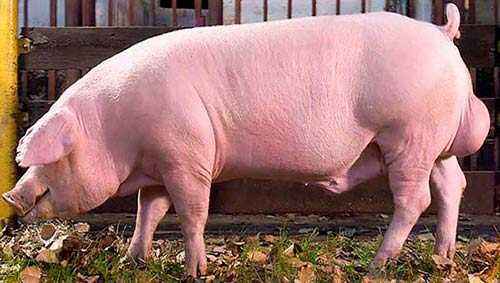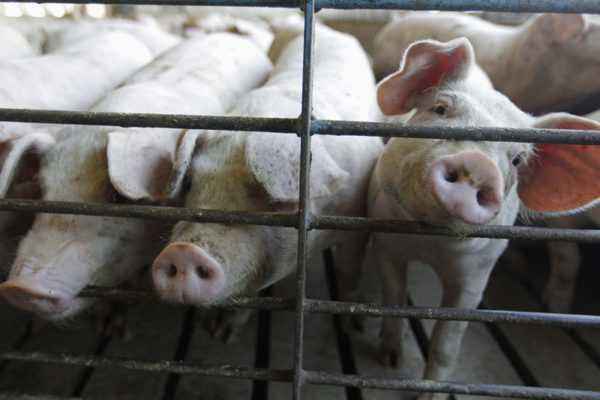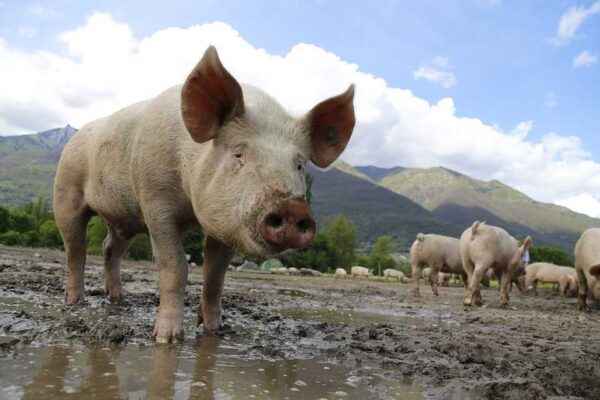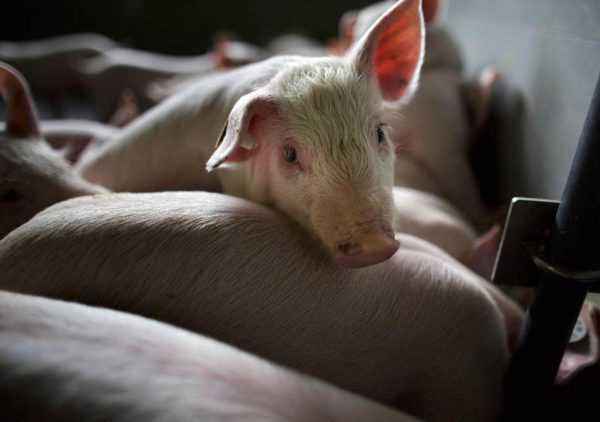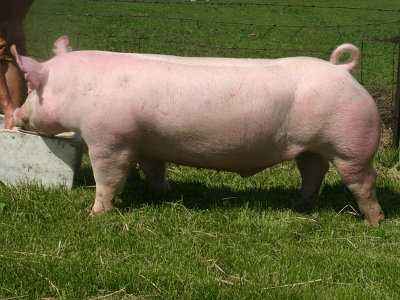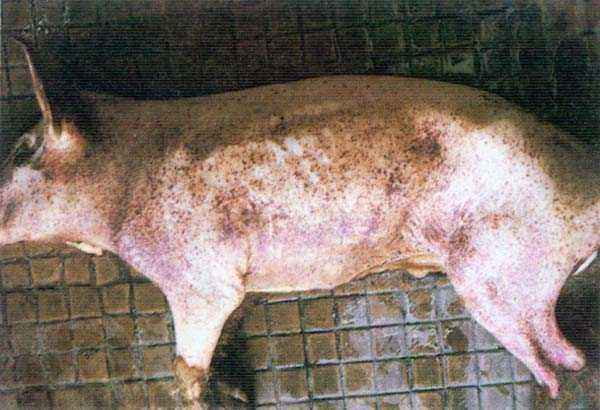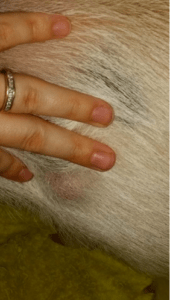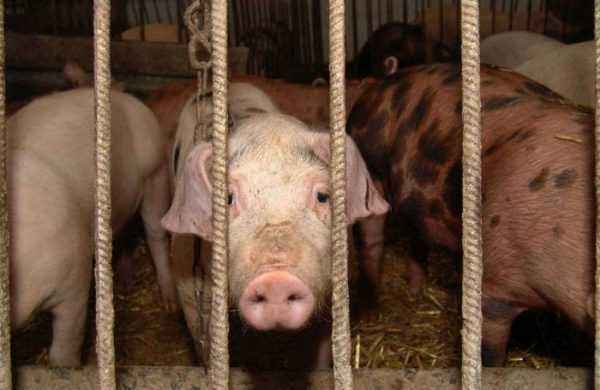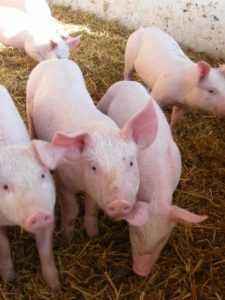Among the skin diseases of animals, scabies in pigs, or sarcoptosis, which in the absence of timely measures can develop into neglected forms and take generalized symptoms, are quite common.
- Etiology of sarcoptosis
- Contributing factors and causes
- Symptoms of sarcoptosis
- Diagnosis and treatment
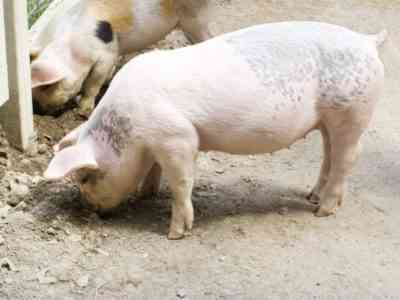
Scabies in pigs
Etiology of sarcoptosis
The causative agent of scabies in pigs is an intradermal parasitic tick. 0.5 mm. a tick is a gnawing oral apparatus by which it penetrates the skin. When it enters the skin, female mites lay 2-8 eggs per laying, gradually moving under the skin. Over the entire period of existence, which is about 22-30 days , a female parasitic tick can lay up to 60 eggs.
In diseases with sarcoptosis, animals begin to show anxiety due to constant itching. Crusts or gross folds appear on the affected areas.
In the larval stage, which lasts for 3-5 days, the parasites feed on epidermal cells.As they grow older, the larva passes into the teleonymph stage, at which it is able to fertilize, and for this purpose it reaches the surface of the skin, settling in new areas of the skin.
Parasites that cause sarcoptosis can move to other animals and represent potential danger to humans.
The causative agent of scabies is able to maintain its viability outside the host for 2 weeks. When the temperature drops to -5 ° C, it dies after 1-5 days, when the environment is heated to 50 ° C, 30-40 minutes are enough for the death of the tick. To instantly destroy the scabies mite, an increase in temperature to 80 ° C is necessary.
Contributing factors and causes
Invasive individuals are the main source of infection. The most active carriers of the disease are boars in contact with all sows in the stock.
In the case of close constant contact with invasive individuals, scabies in pigs become protracted due to cyclically repeated stages of infection.
In addition to diseased animals, parasites can be carried on clothing of technical personnel and technical equipment. Small rodents, domestic cats and dogs act as mechanical carriers of scabies mites.
An uninfected corral can act as a source of infection for healthy individuals.
Among the causes of sarcoptosis, there are:
- violation of a complete diet,
- vitamin A deficiency,
- an excess of calcium,
- stressful conditions of animals associated with changes in conditions of detention and transportation,
- violation of sanitary standards for keeping animals,
- excessive crowding of the livestock,
- dampness in the room where animals are kept,
- lack of regular walks.
Sarcoptosis disease often has a seasonality. The greatest risk of infection occurs in the autumn and early spring days. In summer, the peak of the disease decreases, but you can’t rely on self-healing of animals.
Young people often suffer from sarcoptosis before they reach the age of one. Piglets at the age of 2-5 months are most at risk.
A massive loss of livestock leads to economic damage to the pig farm, including:
- leads to mortality of young animals,
- slows down the growth rate of piglets,
- increases feed costs and the cost of veterinary services,
- limits profit due to quarantine restrictions on the sale of animals and meat products.
Symptoms of sarcoptosis
Penetrating through her gnawing mouth apparatus, itch mites injure the skin and cause inflammatory processes that begin to spread deep into the layers of the epidermis. The inflammatory process can be aggravated by allergic reactions to the vital activity of parasites.
The incubation period of scabies in pigs lasts up to 2 weeks.
Inflammation caused by ticks entering the body leads to thickenings and swelling of the skin, which are the initial signs of illness in piglets and pigs. As sarcoptosis develops, changes occur that damage the hair follicles, causing stubble to fall out. The resulting epidermal microtraumas serve as a place for other infections to enter.
Among the main symptoms of scabies in piglets and signs of skin lesions with pig scabies in pigs, the following are distinguished:
- initial redness with red dots – places under parasite skin,
- the appearance of small sizes of abscesses,
- the formation of crusts on injured and combed areas,
- roughened areas of the skin,
- thickening and wrinkling,
- loss of elasticity by the epidermis,
- appearance in the forest GOVERNMENTAL forms bleeding cracks.
Symptoms of mange in pigs are most noticeable on the ears, the eyes, around the snout.Gradually, in advanced forms of the disease, ticks spread to the back and sides, down the abdomen and to the inner thigh. Among other signs is the formation on the skin of foci with gray-white crusts that cause itching.
With all local symptoms, general intoxication and exhaustion sometimes appear, often leading to death.
With an untimely prescribed treatment, small foci begin to merge with each other, the barks change in color to black and brown. The skin of pigs begins to thicken with characteristic folds of coarse origin. Severe lesions lead to neurological changes in the behavior of pigs that become aggressive.
Diagnosis and treatment
The diagnosis of the disease is made on the basis of laboratory studies, taking into account the obtained epizootological data and symptoms. Scrapes from the auricles, taken from more than 10% of the livestock, are sent to the laboratory. In the case of detected sarcoptosis, a differentiation of the diagnosis is made with other skin diseases: deprivation, demodicosis, pediculosis. After a confirmed diagnosis, treatment for scabies in pigs is prescribed.
Among the main drugs than treating scabies in pigs, there are:
- aerosols for topical application in the form of spraying,
- solutions for external use in the form of spraying,
- solutions for the preparation and administration of injections,
- feed additives.
The most effective method for treating scabies in piglets and adults is the injection of anti-mite drugs , the dosage and effect of which depends on the weight of the animal. The greatest efficacy in the treatment of sarcoptosis was shown by such agents as doramectin and ivermectin, which are used as anti-scabies, administered subcutaneously with repeat after 2 weeks.
Before using external solutions for treatment, the affected areas of the epidermis are pre-cleaned of contamination and formed crusts using a soap solution with creosote.
There are 2 ways to treat scabies in pigs with solutions for external use: spraying and watering. They do this in the conditions of industrial pig farming and housekeeping using special means: chlorophos, creolin, dipericide, amitraz, ectosinol, which are sprayed or watering animals in the pen.
Among folk methods, cure sarcoptosis is a sour cream mixture with gunpowder made of 3: 1 ratio, infused for 3 hours, with which the affected areas of the epidermis are treated. As other folk remedies for external treatment, garlic tincture is used.
